This article is part of the 31 Days of Pinterest Hacks series. Find the main page for this series here.
One year, when I was still in the classroom, I ran a knitting club during lunch. I was surprised that many of the students who signed up were boys. More than that, many were children with learning disabilities or those who needed social/emotional support. Not all of them learned to knit that year, but what they learned was an excellent lesson for me. The seemingly simple act of spinning yarn into a ball calmed them down almost immediately. I witnessed a room full of children focused and incredibly serene.
For whatever reason, handwork is an art that the children aren’t getting enough of in the classrooms. How can we offer activities such as knitting to children who require fine motor support?

Just look at all the knitting activities found on Pinterest!
Why knitting may be a challenge for neurodivergent and disabled children
- Children requiring fine motor support may find the technique too demanding to coordinate.
- Children with tactile sensory aversions may find the yarn a difficult texture to manipulate.
Suggestions for adaptations/modifications for yarn play
- Free exploration. Allow the child to play with strings of yarn in a sensory bin, or simply allow them to play with balls of yarn. If the child struggles with the texture, begin with satin ribbons, soft raffia, and rope-like spools. Work their way up to the yarn.
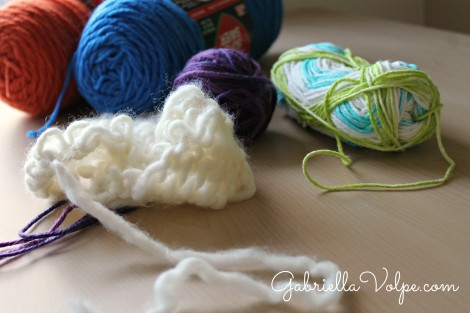
Play with various colors and thicknesses of yarn. Each of the skeins above has a different texture. I suggest beginning with the thickest yarn you can find as it’s easiest to manipulate.
- Wind into a ball. Model how to do this for a few days while the child observes. Then, set up a small ball for the child and have them wind the unravelled yarn into a ball. You may need to do this hand-over-hand for a while (always with consent). Sit behind them while you guide them—encouraging the pincer grasp.
- Create a verbal routine. When winding yarn, create a verbal routine like: “Round, and round, and round we go” or sing a short song like “Ring around the Rosie.” Keep it consistent with this activity.
- Wind around objects. Practice the same skill by winding around familiar objects like blocks and toys. Ensure that they’re thick and somewhat long.
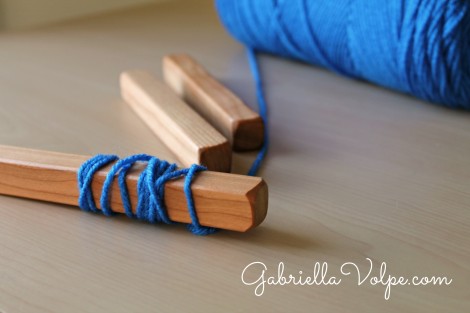
We wound around my son’s wooden blocks.
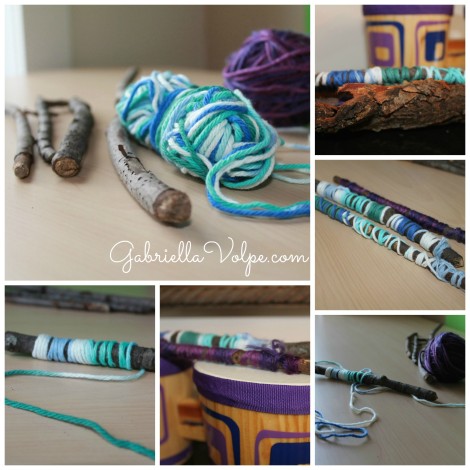
Wind around branches too. For safety reasons, be sure to find thick but short branches.
- Wind around a loom. Rather than rolling in a circular motion, have the child practice winding sideways around a DIY loom. Criss-cross around sticks in a circle. See the images below for an explanation. Vary the direction the hands go. This is a pre-finger knitting/pre-crocheting practice!

This is a DIY pre-finger knitting loom. I found the idea for a variation of this on Pinterest. Hot glue a large popsicle stick to a toilet paper tube. Wind elastics to hold in place. Practice winding yarn with one stick. Have the child hold the tube with one hand while winding around and around the stick with the other. They’re not making anything. The exercise is to practice winding around one vertical stick.
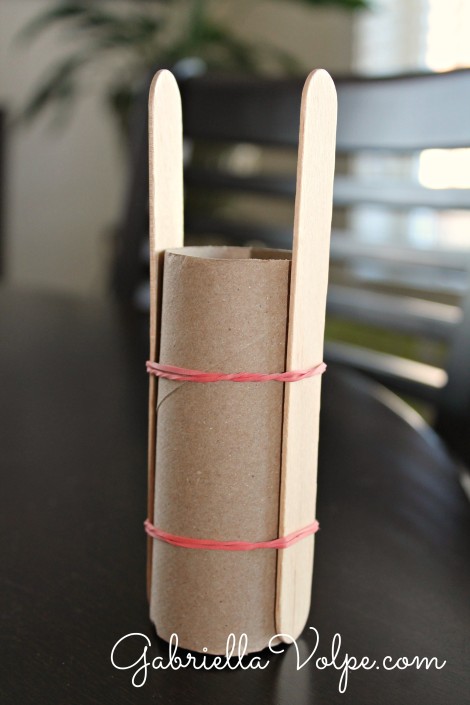
Progress to a two-pronged loom. This time, wind around one stick, then the other. Alternate repeatedly. Again, the child isn’t making anything. The exercise is to practice winding yarn around two sticks.
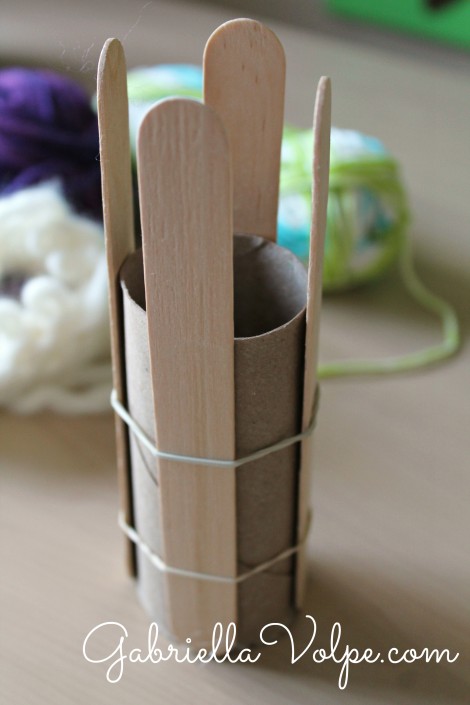
Increase the number of sticks on the loom until you create a loom with four prongs. Again, wind around one, wind around the next and continue in a circular fashion. Unless you think the child might be ready for finger knitting using this loom, practice the winding for some time. That’s some tricky work!
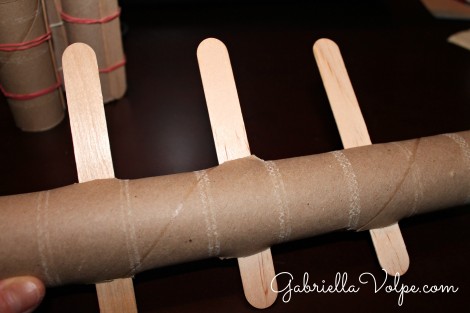
More practice with winding yarn around sticks. I cut slits into a paper towel tube and inserted the large popsicle sticks right through. The fine motor practice here is winding the yarn from left to right.
- If the child is ready, teach them to finger knit. There are many tutorials pinned on Pinterest. Always model first, hand-over-hand (with consent), then let them fly!

This is my favorite book for teaching children to knit (although it’s great for beginning adults to learn from here too!)
What tips can you share for yarn play?
If you need personalized support for fine motor practice for a child, I’d love to help you find them. I offer one-to-one consultations for parents, educators, and clinicians.

I don’t knit and have stayed away from anything like this because I know what a struggle it will be for my son (quad CP). I like the idea of winding around a branch with my guidance. I think I’ll put that on my list of fall crafts. Thanks for sharing! I am very much enjoying this series and so glad to have found you on the 31 Days list.
Oh, boy, do I ever hear you, Catherine. I have picked up knitting in the last four years myself, and each time I work on a project I think about how amazing it would be if my son learned this craft. However, I thought it would be impossible to even pretend to have my son knit. It still might be, but I want him to get as close to the skills this craft offers. I knew he’d be able to touch yarn, so I did that. Then, I thought about what else he could do with it besides pull it apart in a pile.
Even though he’s not doing it on his own, the winding action is helping to build brain connections that weren’t there before. You should see the excitement in his eyes when I pull out the yarn. He sits up and waits for me to place my hands over his. He just knows what’s coming next, and I can feel the movement in his hands – trying to go in the direction of “round and round”. Who knows how far I can take this over time.
I’m happy you clicked on that button, Catherine! Thanks for letting me know how you found me.